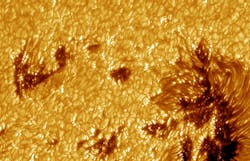Mikrotron high-speed camera improves AO imaging in the Swedish Solar Telescope
Located on the Canary Island of La Palma, the Swedish 1-meter Solar Telescope (SST) is performing high-resolution observations of the Sun. It is operated by the Institute for Solar Physics (ISF), which is part of Stockholm University's department for Astrophysics. Research at the institute primarily aims to gain knowledge about the outer layer of the solar atmosphere, which is dominated by magnetic fields.
The mystery of the sun is explored using observational data registered with the Swedish Solar Telescope. The telescope system looks at 60 x 60 arc-seconds of the Sun, which equals 43,320 x 43,320 km on the solar surface. This is an area that is more than three times bigger than the Earth's surface but represents only 0.03% of the Sun's surface.
The telescope uses adaptive optics (AO) to reduce the effects of atmospheric distortion. Atmospheric distortion is caused by the Earth's atmosphere, which bends the light in random directions. Without adaptive optics, the Swedish Solar Telescope would generate blurry images.
The adaptive optics system within the Swedish Solar Telescope, which was funded by the Swedish Research Council, consists of a Shack-Hartmann wavefront sensor and a deformable mirror. The Shack-Hartmann wavefront sensor is a glass plate with many lenslets etched on it, which subdivide the pupil of the telescope in 85 segments. Each segment delivers an individual image of the Sun. When the atmosphere disturbs the image, it causes the image to shift, and this shift is different for each segment. The shifts are measured and translated into commands to the deformable mirror, so that it takes a shape that compensates for the distortions.
The problem is that the atmosphere changes quickly, so this has to be done very accurately and at a very high frequency. The adaptive optics system at the Swedish Solar Telescope has to correct the deformable mirror at least several hundred and preferably more than 1000 times per second. This requires high-speed equipment.
The EoSens CL high-speed camera by Mikrotron was installed and is now used to record images formed by the Shack-Hartmann wavefront sensor. The honeycomb pattern that is created is composed of many small images of the Sun, each produced by one segment of the pupil. As the image is being sent to the computer, it is already being processed. By the time the last lines of the camera image are being received, the computer has already calculated the phase variation of the whole pupil. It then calculates how to shape the mirror to produce an inverse phase variation. Within one second, 2000 images are extracted, pre-processed and measured.
At the Swedish Solar Telescope, both the digital gain and the fixed-pattern noise (FPN) correction are switched off to ensure the EoSens CL delivers raw data. "The reason we do not want the camera to do any corrections is because our optical system itself is not perfect, and also introduces variations in gain and offset for each pixel," explain one of the research engineers. "So we measure the dark field and flat field for the whole optical system, and apply the correction using our software." One exception is the black level offset. It is raised accordingly to ensure that, even in total darkness, the pixel values are always above 0."
SOURCE: Mikrotron; http://campaign.r20.constantcontact.com/render?m=1101299627445&ca=22161161-a68e-49e2-8cb4-418a9eafb959
About the Author

Gail Overton
Senior Editor (2004-2020)
Gail has more than 30 years of engineering, marketing, product management, and editorial experience in the photonics and optical communications industry. Before joining the staff at Laser Focus World in 2004, she held many product management and product marketing roles in the fiber-optics industry, most notably at Hughes (El Segundo, CA), GTE Labs (Waltham, MA), Corning (Corning, NY), Photon Kinetics (Beaverton, OR), and Newport Corporation (Irvine, CA). During her marketing career, Gail published articles in WDM Solutions and Sensors magazine and traveled internationally to conduct product and sales training. Gail received her BS degree in physics, with an emphasis in optics, from San Diego State University in San Diego, CA in May 1986.
